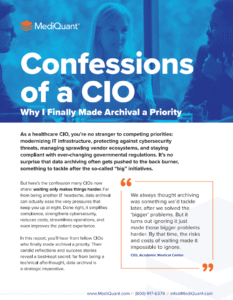Preserving the Past to Power the Future: Why Legacy Data Matters in Healthcare’s Next Chapter
If there is one constant in healthcare information technology, that’s the demand for change. Whether that change is driven by regulatory compliance, or efforts to improve patient outcomes, reduce costs, or promote efficiencies, new systems are constantly being deployed and monitored for the desired outcome. Behind every new electronic health record (EHR) implementation, AI pilot project, and cloud migration effort, there are decades of patient data that must be preserved, protected, and made accessible. In many ways, that legacy data becomes the bridge between a hospital’s past and its future.
Throughout my career in healthcare IT, from implementing SMS systems in the 1980s to overseeing modern data management strategies today, another constant has emerged: old systems don’t simply disappear when new ones arrive. They must be thoughtfully retired, responsibly archived, and securely maintained. Otherwise, healthcare organizations risk not only compliance violations but also operational and financial burdens that reduce margins and hinder progress.
Today, the stakes are even higher. Hospitals are under immense pressure to innovate, which for many means embracing AI, digitizing workflows, and delivering better patient experiences, all while grappling with aging IT infrastructure. Many are still paying to maintain systems installed decades ago, despite no longer using them for daily operations. Supporting these obsolete environments drains resources and creates vulnerabilities, from cybersecurity risks to workforce challenges, as the specialized expertise needed to maintain older systems becomes increasingly rare.
This is where application rationalization and active archiving become strategic imperatives, not just technical exercises. By systematically identifying dormant systems and migrating critical data into modern, accessible platforms, healthcare organizations can reduce costs, strengthen security, and free up IT talent to focus on the future. Importantly, this also protects organizations during events like ransomware attacks by ensuring historical records remain accessible even if primary systems are compromised.
But achieving these outcomes requires more than good technology. It demands a culture of continuous learning and connection — both with our customers and within our own teams. At MediQuant, we have leaned heavily into fostering a spirit of collaboration and experimentation through initiatives like our Center for Innovation and Collaboration. We’ve encouraged our teams to challenge old processes, find smarter ways to work, and to securely take risks, always with the ultimate goal of serving hospitals more effectively and safely.
Employee engagement is critical in this equation. In a mostly remote environment, we prioritize personal touches, whether it’s a virtual coffee break, a birthday card, or celebrating a successful go-live. We believe that building strong relationships across teams and with our customers isn’t just good for morale; it directly impacts project success and client satisfaction. Healthcare IT work may not always be flashy, but when done well, it truly can change lives by enabling better care at the bedside.
As healthcare’s digital transformation accelerates, the ability to honor and harness the past while investing in the future will differentiate the organizations that thrive. Legacy data isn’t a burden to be forgotten. It’s an asset that, when properly managed, empowers innovation, resilience, and meaningful progress.
Our mission is simple: liberate data, so hospitals can liberate resources, and ultimately, save more lives. That’s why we show up every day, and why we’re proud to stand alongside healthcare organizations as they write the next chapter of their story.
Mary Pat Fralick is Chief Operating Officer, MediQuant
More Thought Leadership
Confessions of a CIO: Why Data Archival is Key to IT Success
As a healthcare CIO, you’re juggling countless priorities—modernizing IT infrastructure, managing cybersecurity threats, and staying compliant with ever-changing regulations. It’s no wonder data archiving often gets pushed to the back burner. But here’s the truth:...
How to Avoid the #1 EHR Data Conversion Mistake (Hint: It’s Scope)
The riskiest part of your EHR data conversion isn’t the data. It’s the scope creep no one sees coming. Most healthcare organizations underestimate how many systems, data types, and workflows are tangled together. Even less have a grasp on the number of staff needed to...
Partner Highlight: Firely + FHIR = Interop in Motion
Bringing FHIR to Life Firely provides the software and expertise to bring FHIR (Fast Healthcare Interoperability Resources) to life. Their flagship tools—Firely Server, Simplifier.net, and the official HL7 FHIR .NET SDK—power some of the world’s most advanced health...
Contact Us Today







